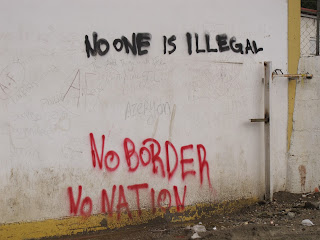Lesvos Day 1 - January 5, 2016 Moria Camp

I arrived on Levos with no issues. Kelly Milligan from Sisters In Health was waiting for me at the airport to guide me to her home, which she has graciously shared with me for the few days I am here.
Kelly came to Lesvos with her husband Scott to work with Health Point Project – the first healthcare provision for refugees outside Moria camp – and by far the busiest. I had contacted Hadia the founder of HPP when she first began about setting up a women’s focus and she agreed it was necessary. I then contacted Kelly and the rest is history – but with a few side stories along the way. HPP has changed its focus and another entity has taken over – but fortunately healthcare is still available. Sisters in Health are independent and do continue to work with other groups when needed.
Kelly and Scott have taken an area inside the compound in a place designated for the most vulnerable, creating an oasis in the midst of chaos and turmoil. Their clinic at Moria Family Compound, is open far more than any of the others within the camp (MSF and Praxis) and at times when the population tend to need the most care. In addition, due to the success of the work they are doing they are able to fill their roster with providers who can also do outreach within the camp and in times of need outside the camp as well.

My first glimpse of Moria was just a few short months ago when my husband went over to volunteer and was a major player in the setup of HPP. At the time he described the compound (which resembles a prison with high walls and barbed wire, and in fact may have once been a prison) as a place where only those who have registered were allowed in – and sometimes registration takes days, longer for ethnicities not deemed urgent. Those who were vulnerable were supposed to be allowed entry at all times, but it often was difficult and sometimes impossible.
The hill outside the compound is an olive grove and tended to be filled with non-Syrians (who get priority for registration) and was deemed Afghan Hill. At the time other than the clinic tent set up only people and the flimsy tents they had to protect them from the elements were there.
 It has certainly changed. The hill is now crowded with food vendors, a large “barn” (which is more like a long rounded structure) which houses the clinic, a children’s tent, chai tent, food distribution, clothing distribution, bathroom facilities, even vending machines, as well as many different tents for various NGOs crowd the hill and new hopefully sturdier tents for shelter dot the landscape. It was so chaotic I found it difficult to find anything and wonder where the refugees will be able to find places to rest when the population increases as spring and summer descend. People come and go a bit easier, and the area for vulnerable population is more accessible. Volunteers have stepped up and ensured food is provided for all meals and while far from ideal, there are ore resources and assistance.
It has certainly changed. The hill is now crowded with food vendors, a large “barn” (which is more like a long rounded structure) which houses the clinic, a children’s tent, chai tent, food distribution, clothing distribution, bathroom facilities, even vending machines, as well as many different tents for various NGOs crowd the hill and new hopefully sturdier tents for shelter dot the landscape. It was so chaotic I found it difficult to find anything and wonder where the refugees will be able to find places to rest when the population increases as spring and summer descend. People come and go a bit easier, and the area for vulnerable population is more accessible. Volunteers have stepped up and ensured food is provided for all meals and while far from ideal, there are ore resources and assistance.Memories:
The family from Afghanistan whose mother was struggling to walk but still had to make it up and down the steep hill to the compound to sleep. She also suffered from incontinence and it became very clear that donations are focused on the very young but not the needs of adults or elderly.
The look of joy on the faces of children as they watched bubbles float through the air at the food tent.
The myriad of volunteers from all over the world dedicated to helping those in need. It was heartwarming.





No comments:
Post a Comment